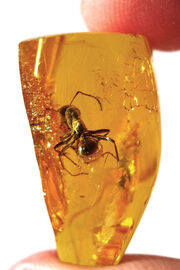
Whether it is the static electricity that comes off your clothes out of the dryer, to the giant displays of lightning in thunderstorms, people have been fascinated by electrical charge for millennia.
It was the Greeks who noted the idea of static when they rubbed amber on their clothes, to produce the characteristic effects of attraction and repulsion. The Greek word for amber is ελεψτρον (electron)
But what is charge? It was only in the last 300 years that we developed a better understanding of electrical charge. Nonetheless, even today, we know materials can possess charge, but at best we are simply describing how it behaves, not what causes electrical charge at the fundamental level.
We will start in the series of lessons about what charge is and how we describe it and explain its behaviour. In subsequent lessons we will look at systems where the charge is moving consistently, such as in electrical circuits.
Then later we will look at how electrical charges behave in various fields such as electric fields and magnetic fields.
It was the Greeks who noted the idea of static when they rubbed amber on their clothes, to produce the characteristic effects of attraction and repulsion. The Greek word for amber is ελεψτρον (electron)
But what is charge? It was only in the last 300 years that we developed a better understanding of electrical charge. Nonetheless, even today, we know materials can possess charge, but at best we are simply describing how it behaves, not what causes electrical charge at the fundamental level.
We will start in the series of lessons about what charge is and how we describe it and explain its behaviour. In subsequent lessons we will look at systems where the charge is moving consistently, such as in electrical circuits.
Then later we will look at how electrical charges behave in various fields such as electric fields and magnetic fields.
An introduction to Electric Charge
Often a teacher might introduce electrical charge by doing a demonstration.
Here are two demonstrations that are done in the classroom. They demonstrate the conservation of charge.
Here are two demonstrations that are done in the classroom. They demonstrate the conservation of charge.
|
The first examines how an electroscope works, using the principles of attraction and repulsion, and the movement of electrical charges as a result.
|
The second video is similar in that it demonstrates the conservation of charge. Since only some charges are transferred to a material, the rod and the cube may at some point have the same charge, and at other points have different charges. This results in different behaviours.
|
Theory
Starting with a historical overview of our understanding of electrical charge. this video examines the basis of electrical charge, namely the electron and the proton. It's only also examines one of the conservation laws, concept of conservation of charge.
Starting with a historical overview of our understanding of electrical charge. this video examines the basis of electrical charge, namely the electron and the proton. It's only also examines one of the conservation laws, concept of conservation of charge.
Going Deeper
In the video I discussed how ultimately a charge is determined by the number of electrons and protons present in the material. The presumption is that electrical charge at a fundamental level is discrete, based on the number of protons and electrons.
However this is problematic.
Electrons, based on the standard model are a fundamental particle. That is, they are indivisible and so if we assign a discrete value to charge we often assign it with a -1. Consequently, we assign a +1 charge to the proton. Therefore in a neutral atom, we have the same number of protons and electrons.
But protons are not fundamental particles. According to the Standard Model, protons are particle groups, made up of quarks, two up quarks and one down quark. As a result the up quark has a charge of +2/3, and the down quark has a charge of a -1/3.
So although charge is a discrete value, the values of +1 and -1 arbitrary.
You can see more on the standard model here
In the video I discussed how ultimately a charge is determined by the number of electrons and protons present in the material. The presumption is that electrical charge at a fundamental level is discrete, based on the number of protons and electrons.
However this is problematic.
Electrons, based on the standard model are a fundamental particle. That is, they are indivisible and so if we assign a discrete value to charge we often assign it with a -1. Consequently, we assign a +1 charge to the proton. Therefore in a neutral atom, we have the same number of protons and electrons.
But protons are not fundamental particles. According to the Standard Model, protons are particle groups, made up of quarks, two up quarks and one down quark. As a result the up quark has a charge of +2/3, and the down quark has a charge of a -1/3.
So although charge is a discrete value, the values of +1 and -1 arbitrary.
You can see more on the standard model here
